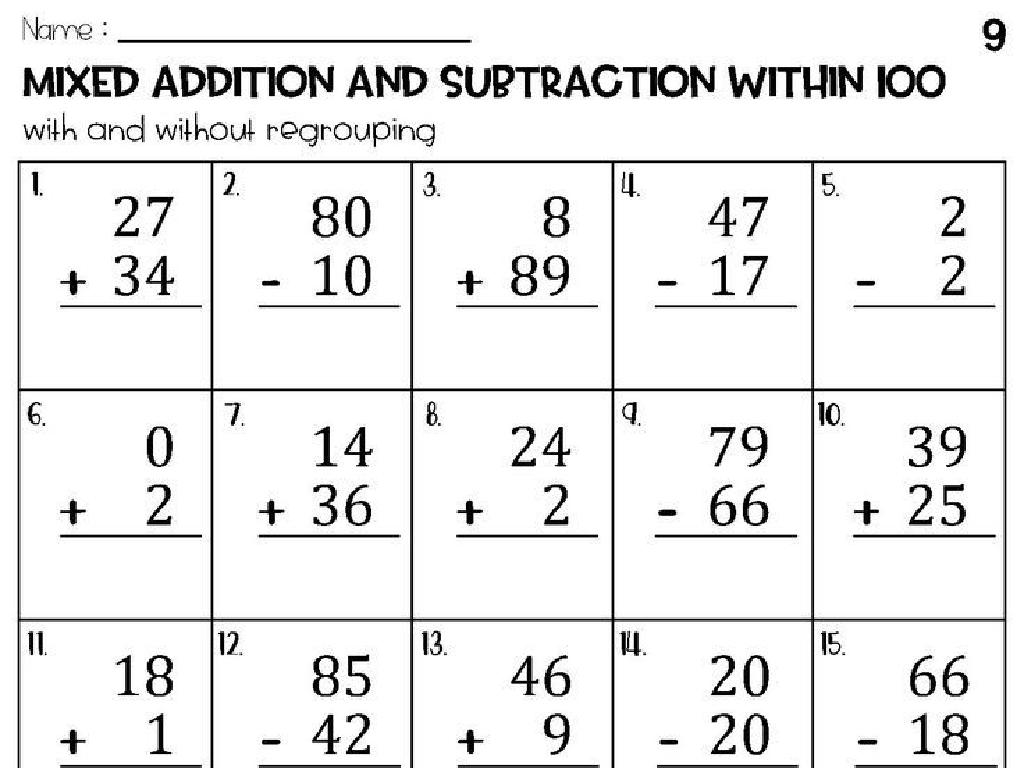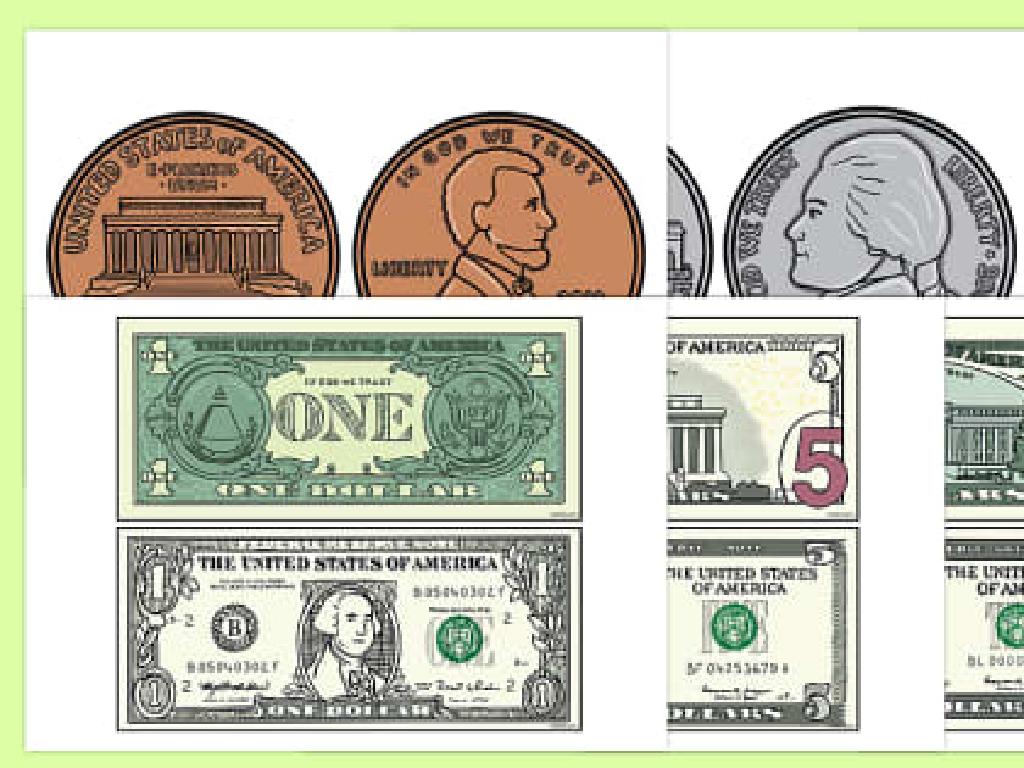Equivalent Rates
Subject: Math
Grade: Sixth grade
Topic: Ratios And Rates
Please LOG IN to download the presentation. Access is available to registered users only.
View More Content
Understanding Equivalent Rates
– What are ratios and rates?
– Ratios compare two quantities, like 2 apples for 3 oranges.
– Rates in daily life
– Speed is a rate: miles per hour or cost per item.
– Exploring equivalent rates
– Equivalent rates have different numbers but the same ratio.
– Practice with real examples
|
Begin the lesson by defining ratios and rates, ensuring students grasp that ratios are comparisons, while rates are a special type of ratio expressing how one quantity changes in relation to another. Illustrate with everyday examples, such as speed limits or price per pound of fruit, to make the concept relatable. Introduce equivalent rates by explaining that they are different representations of the same comparison. Use examples like 60 miles in 1 hour is the same rate as 120 miles in 2 hours. Encourage students to find other examples of equivalent rates in their daily lives and be prepared to solve problems involving finding equivalent rates.
Understanding Ratios
– Ratios compare values
– A ratio shows how much of one thing there is compared to another, like the number of apples to oranges.
– Ratios have three forms
– They can be written as ‘3 to 4’, ‘3:4’, or as a fraction ‘3/4’.
– Real-life ratio examples
– Examples: recipe ingredients, mixing paint, or speed (miles/hour).
– Ratios in math problems
|
This slide introduces the concept of ratios, which are a fundamental part of understanding rates and proportions in mathematics. It’s important to explain that ratios are a way to compare quantities and can be expressed in different forms. Use everyday examples to illustrate ratios, such as recipes (2 cups of flour to 1 cup of sugar) or speed (60 miles per hour). Emphasize that understanding the different ways to write ratios is crucial for solving problems involving equivalent rates. Encourage students to think of their own examples and to recognize ratios in various contexts.
Understanding Rates
– Define a rate
– A rate compares two different units, like miles per hour.
– Speed as a rate example
– For instance, driving 60 miles in 2 hours means a rate of 30 mph.
– Explore various rate examples
– Examples: heartbeats per minute, price per gallon.
– How rates relate to daily life
– Rates help us make decisions, like choosing the best buy.
|
This slide introduces the concept of rates, which are special types of ratios that compare two different units. Use speed as a relatable example to show how distance and time are compared in rates. Discuss various examples of rates such as heart rate, fuel efficiency, and cost comparisons to illustrate the concept. Emphasize the practicality of understanding rates in everyday life, such as in budgeting, planning travel time, or maintaining health. Encourage students to think of rates they encounter daily and be prepared to discuss these in class.
Understanding Equivalent Rates
– Definition of equivalent rates
– Rates with different numbers but the same ratio
– Example of equivalent rates
– 60 miles/1 hour is the same as 120 miles/2 hours
– Finding equivalent rates
– Use multiplication or division to find other rates
– Multiplication and division method
– Multiply or divide both terms by the same number
|
This slide introduces the concept of equivalent rates, which are different numerical rates that express the same relationship between quantities. For example, traveling 60 miles in 1 hour shows the same rate as traveling 120 miles in 2 hours. To find equivalent rates, students can multiply or divide both the numerator and the denominator of the rate by the same number. This is a fundamental skill in understanding ratios and proportions, and it’s important for students to practice this with various examples. Encourage students to think of other real-life scenarios where they might need to find equivalent rates, such as cooking or shopping.
Finding Equivalent Rates
– Scale rates using multiplication/division
– Multiply or divide both terms of a rate to find an equivalent rate.
– Maintain equivalent relationships
– The ratio between the two quantities must stay the same.
– Example: Converting rates together
– If a car travels 60 miles in 2 hours, how far does it travel in 5 hours?
– Practice with different rates
|
This slide introduces the concept of finding equivalent rates by scaling the terms of a given rate up or down through multiplication or division. It’s crucial that students understand the relationship between the terms must remain consistent to maintain equivalence. Walk through an example problem as a class to demonstrate the process. For instance, if a car travels 60 miles in 2 hours, to find out how far it travels in 5 hours, we scale the hours up by multiplying both terms by 2.5, resulting in 150 miles in 5 hours. After the example, encourage students to practice with different rates to solidify their understanding.
Practice Problems: Equivalent Rates
– Work on problems as a class
– Find equivalent rates
– If 3 apples cost $1.50, what’s the cost of 10 apples?
– Discuss solution strategies
– Share different ways to solve the problems
– Reflect on methods used
– Why do certain methods work better?
|
This slide is designed for an interactive class activity focused on finding and understanding equivalent rates. Start by solving problems together, guiding students through the process of finding equivalent rates. For example, if 3 apples cost $1.50, how much would 10 apples cost? Encourage students to discuss their solutions and the strategies they used, fostering a collaborative learning environment. Reflect on the methods used, discussing why some strategies might be more effective than others. This activity will help students grasp the concept of equivalent rates by applying it to real-world scenarios, enhancing their problem-solving skills and mathematical reasoning.
Real-World Application of Equivalent Rates
– Understanding equivalent rates
– Shopping price comparisons
– Compare unit prices to get the best deal
– Identifying real-life situations
– Look for examples in cooking, driving, or sports
– Applying knowledge of rates
– Use equivalent rates to make informed decisions
|
This slide aims to show students how the concept of equivalent rates is used in everyday life, particularly in making smart shopping decisions. By comparing unit prices, students can determine the best buy. Encourage them to think of other situations where they can apply this knowledge, such as determining the cost of ingredients when cooking, comparing distances and travel times when driving, or calculating points per game in sports. The goal is to help students see the value of math in practical decision-making and to reinforce their understanding by applying it to familiar contexts.
Class Activity: Rate Race!
– Find equivalent rates in groups
– Apply knowledge to real-world scenarios
– How many miles per hour if you walk 2 miles in 30 minutes?
– Solve problems collaboratively
– Present findings to the class
|
This interactive class activity encourages students to work in groups and apply their understanding of equivalent rates to solve real-world problems. Provide students with various scenarios, such as walking distances, cooking recipes, or currency exchange. Each group should find as many equivalent rates as possible within a set time frame. Encourage them to use unit rates and scaling to discover equivalencies. After the activity, each group will present their findings, explaining how they determined the equivalent rates. This will help reinforce their understanding and allow for peer learning. Possible scenarios for the activity: 1) If a car travels 60 miles in 1 hour, how far does it travel in 2, 3, or 4 hours? 2) A recipe needs 3 cups of flour for 2 cakes, how much for 5 cakes? 3) If 10 dollars equal 15 euros, how much do 20, 30, or 50 dollars equal?
Wrapping Up: Equivalent Rates
– Recap on equivalent rates
– Rates in daily life
– Understanding rates helps in budgeting, cooking, and more.
– Homework: Find real-life rates
– Look for examples like miles per hour, price per pound, or beats per minute.
– Share examples in next class
|
As we conclude today’s lesson on equivalent rates, remind students of the key concepts and their ability to find rates that are the same despite different representations. Emphasize the practicality of understanding rates in everyday life, such as calculating speed, cost, or efficiency. For homework, students should find and document three examples of rates from their home or community, such as the speed limit on a nearby road, the cost of fruits per pound at the grocery store, or the heart rate during different activities. Encourage them to be prepared to discuss how they found these rates and why they are important. This exercise will help solidify their understanding and recognition of rates in the world around them.






